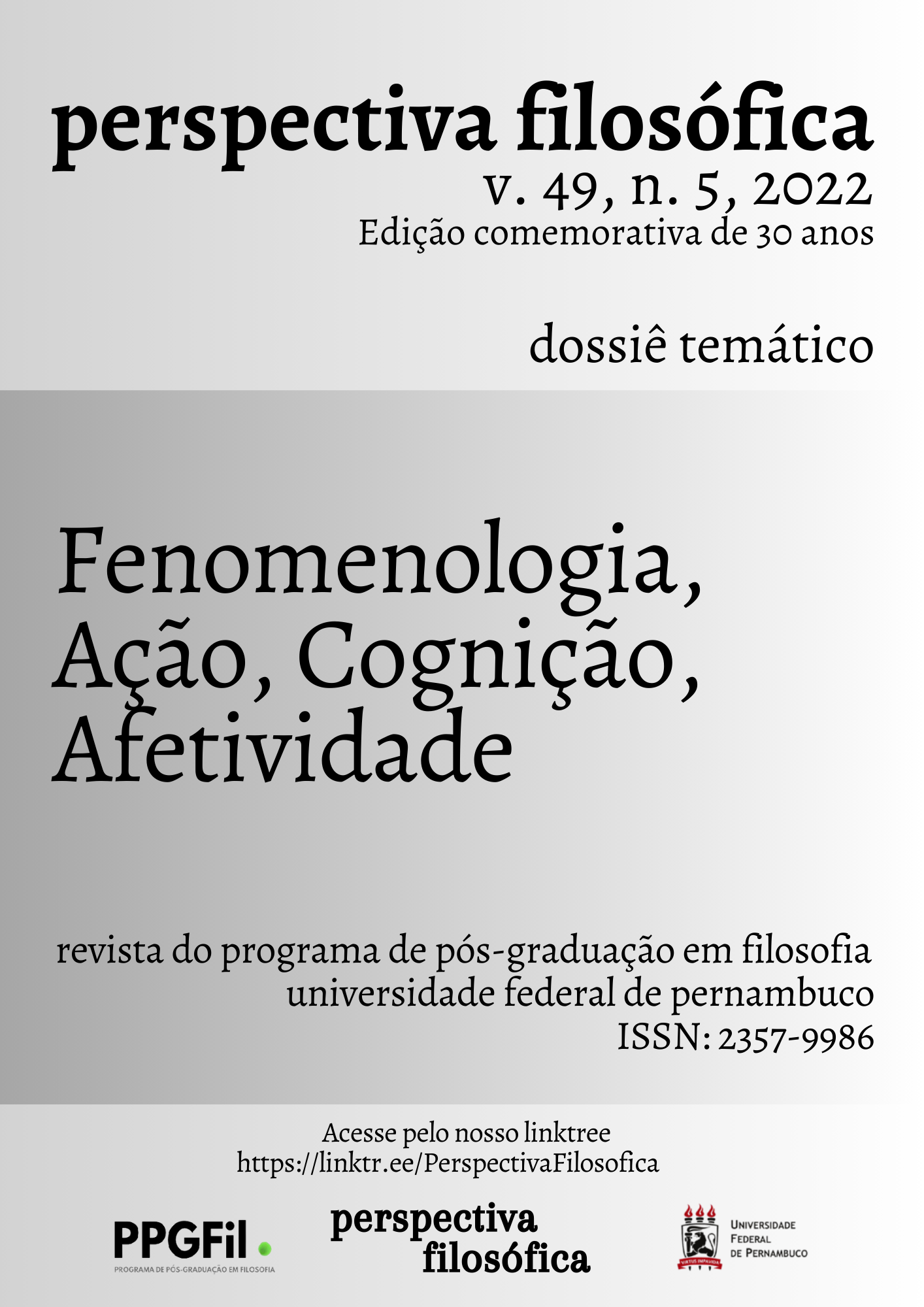La perception des èmotions comme perception de l'affect
DOI:
https://doi.org/10.51359/2357-9986.2022.256755Palabras clave:
émotions, perception, action, perception sociale, théorie de l'espritResumen
Pouvons-nous percevoir des émotions dans le visage d'une autre personne ? Selon certains philosophes, la réponse à cette question est positive : en voyant l'expression faciale de bonheur d'une personne, je perçois aussi son bonheur. Le but de cet article est de montrer que ce n'est pas le cas : lorsque nous voyons l'expression faciale d'une autre personne, nous ne percevons pas l’émotion correspondante, mais plutôt l'aspect affectif de l'émotion. De plus, je formule l’hypothèse que la perception de cet aspect affectif émerge d'une boucle perception-action déclenchée automatiquement lorsque l'observateur voit un visage exprimant une émotion.
Citas
Aviezer, H., Hassin, R. R., Ryan, J., Grady, C., Susskind, J., Anderson, A., & Bentin, S. (2008). Angry, disgusted, or afraid?: Studies on the malleability of emotion perception. Psychological Science, 19(7), 724–732.
Avramides, A. (2000). Other Minds. Routledge.
Barrett, L. F. (1998). Discrete emotions or dimensions? The role of valence focus and arousal focus. Cognition & Emotion, 12(4), 579-599.
Berkeley, G. (1709/1992). Philosophical Works, ed. M.R. Ayers. Dent & Sons.
Crivelli, C., Russell, J.A., Jarillo, S., Fernández-Dols, J.-M. (2016). The fear gasping face as a threat display in a Melanesian society. Proc Natl Acad Sci, 113: 12403-12407
Descartes, R. (1641/2011). Méditations métaphysiques. GF Flammarion.
Ekman, P. (1999). Basic emotions. Handbook of cognition and emotion, 98(45-60), 16.
Gallagher, S. (2008). Direct perception in the intersubjective context. Consciousness and Cognition, 17(2), 535–543.
Goldman, A. I. (2006). Simulating minds: The philosophy, psychology, and neuroscience of mindreading. Oxford University Press.
Hunnius, S., de Wit, T. C., Vrins, S., & von Hofsten, C. (2011). Facing threat: Infants' and adults' visual scanning of faces with neutral, happy, sad, angry, and fearful emotional expressions. Cognition and Emotion, 25(2), 193-205.
Hurley, S. (2001). Perception and action: Alternative views. Synthese, 129(1), 3-40.
Hurley, S. (2008). The shared circuits model (SCM): How control, mirroring, and simulation can enable imitation, deliberation, and mindreading. Behavioral and brain sciences, 31(1), 1-22.
Jacob, P. (2011). The direct-perception model of empathy: a critique. Review of Philosophy and Psychology, 2(3), 519–540.
Hess, U., Adams, R. B., Grammer, K., & Kleck, R. E. (2009). Face gender and emotion expression: Are angry women more like men?. Journal of Vision, 9(12), 19-19.
Hobbes, T. (1651/2002). Leviathan. Édité par A.P. Martinich, Broadview Literary Texts.
Krueger, J. (2014). Emotions and other minds. In R. Campe & J. Weber (Eds.), Interiority/Exteriority: Rethinking emotion. Walter de Gruyter.
Krueger, J. & Overgaard, S. (2012). Seeing subjectivity: defending a perceptual account of other minds. ProtoSociology (47):239-262.
Kulke, L., Brümmer, L., Pooresmaeili, A., & Schacht, A. (2021). Overt and covert attention shifts to emotional faces: Combining EEG, eye tracking, and a go/no‐go paradigm. Psychophysiology, e13838.
Merleau-Ponty, M. (1945). Phénoménologie de la perception. Paris : Gallimard.
Pell, P. J., & Richards, A. (2011). Cross-emotion facial expression aftereffects. Vision Research, 51(17), 1889– 1896.
Prince, S., & Hensley, W. E. (1992). The Kuleshov effect: Recreating the classic experiment. Cinema Journal, 31(2), 59-75.
Russell, J. A. (2003). Core affect and the psychological construction of emotion. Psychological review, 110(1), 145.
Smortchkova, J. (2020). Does empirical evidence support perceptual mindreading?. Thought: A Journal of Philosophy, 9(4), 298-306.
Smortchkova, J. (2017). Encapsulated social perception of emotional expressions. Consciousness and cognition, 47, 38-47.
Spaulding, S. (2015). On direct social perception. Consciousness and Cognition, 36, 472–482.
Valk, J. M. D., Wijnen, J. G., & Kret, M. E. (2015). Anger fosters action. Fast responses in a motor task involving approach movements toward angry faces and bodies. Frontiers in psychology, 6, 1240.
Vetter, P., Badde, S., Phelps, E. A., & Carrasco, M. (2019). Emotional faces guide the eyes in the absence of awareness. Elife, 8, e43467.
Zamuner, E. (2011). A theory of affect perception. Mind & Language, 26(4), 436-451.
Zebrowitz, L. A., & Zhang, Y. (2011). The origins of first impressions in animal and infant face perception. The Oxford handbook of social neuroscience, OUP, 434-444.
Descargas
Publicado
Número
Sección
Licencia
A Revista Perspectiva Filosófica orienta seus procedimentos de gestão de artigos conforme as diretrizes básicas formuladas pelo Conselho Nacional de Desenvolvimento Científico e Tecnológico (CNPq). http://www.cnpq.br/web/guest/diretrizesAutores que publicam nesta revista concordam com os seguintes termos:
Os autores mantém os direitos autorais e concedem à revista o direito de primeira publicação, sendo o trabalho simultaneamente licenciado sob https://creativecommons.org/licenses/by/4.0/deed.pt_BR que permite o compartilhamento do trabalho com reconhecimento da autoria e publicação inicial nesta revista.
Os autores têm autorização para assumir contratos adicionais separadamente, para distribuição não-exclusiva da versão do trabalho publicada nesta revista, com reconhecimento de autoria e publicação inicial nesta revista (Consultar http://opcit.eprints.org/oacitation-biblio.html).

Esta revista está licenciada com uma Licença Creative Commons Atribuição 4.0 Internacional.













